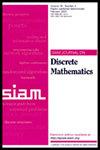Cliques in High-Dimensional Geometric Inhomogeneous Random Graphs
IF 1
3区 数学
Q2 MATHEMATICS
引用次数: 0
Abstract
SIAM Journal on Discrete Mathematics, Volume 38, Issue 2, Page 1943-2000, June 2024.Abstract. A recent trend in the context of graph theory is to bring theoretical analyses closer to empirical observations by focusing the studies on random graph models that are used to represent practical instances. There, it was observed that geometric inhomogeneous random graphs (GIRGs) yield good representations of complex real-world networks by expressing edge probabilities as a function that depends on (heterogeneous) vertex weights and distances in some underlying geometric space that the vertices are distributed in. While most of the parameters of the model are understood well, it was unclear how the dimensionality of the ground space affects the structure of the graphs. In this paper, we complement existing research into the dimension of geometric random graph models and the ongoing study of determining the dimensionality of real-world networks by studying how the structure of GIRGs changes as the number of dimensions increases. We prove that, in the limit, GIRGs approach nongeometric inhomogeneous random graphs and present insights on how quickly the decay of the geometry impacts important graph structures. In particular, we study the expected number of cliques of a given size as well as the clique number and characterize phase transitions at which their behavior changes fundamentally. Finally, our insights help in better understanding previous results about the impact of the dimensionality on geometric random graphs.
高维几何非均质随机图中的群集
SIAM 离散数学杂志》,第 38 卷第 2 期,第 1943-2000 页,2024 年 6 月。 摘要。图论的一个最新趋势是将研究重点放在用于表示实际实例的随机图模型上,从而使理论分析更接近经验观察。据观察,几何不均匀随机图(GIRGs)能很好地表示复杂的现实世界网络,它将边概率表示为一个函数,而这个函数取决于顶点分布在某个底层几何空间中的(不均匀)顶点权重和距离。虽然该模型的大部分参数都很好理解,但还不清楚地面空间的维度如何影响图的结构。在本文中,我们通过研究 GIRG 的结构如何随着维数的增加而变化,对现有的几何随机图模型维数研究和正在进行的确定现实世界网络维数的研究进行了补充。我们证明,在极限情况下,GIRG 接近于非几何非均质随机图,并就几何衰减对重要图结构的影响速度提出了见解。特别是,我们研究了给定大小的簇的预期数量和簇数,并描述了它们的行为发生根本变化时的相变特征。最后,我们的见解有助于更好地理解之前关于维度对几何随机图的影响的结果。
本文章由计算机程序翻译,如有差异,请以英文原文为准。
求助全文
约1分钟内获得全文
求助全文
来源期刊
CiteScore
1.90
自引率
0.00%
发文量
124
审稿时长
4-8 weeks
期刊介绍:
SIAM Journal on Discrete Mathematics (SIDMA) publishes research papers of exceptional quality in pure and applied discrete mathematics, broadly interpreted. The journal''s focus is primarily theoretical rather than empirical, but the editors welcome papers that evolve from or have potential application to real-world problems. Submissions must be clearly written and make a significant contribution.
Topics include but are not limited to:
properties of and extremal problems for discrete structures
combinatorial optimization, including approximation algorithms
algebraic and enumerative combinatorics
coding and information theory
additive, analytic combinatorics and number theory
combinatorial matrix theory and spectral graph theory
design and analysis of algorithms for discrete structures
discrete problems in computational complexity
discrete and computational geometry
discrete methods in computational biology, and bioinformatics
probabilistic methods and randomized algorithms.

 求助内容:
求助内容: 应助结果提醒方式:
应助结果提醒方式:


